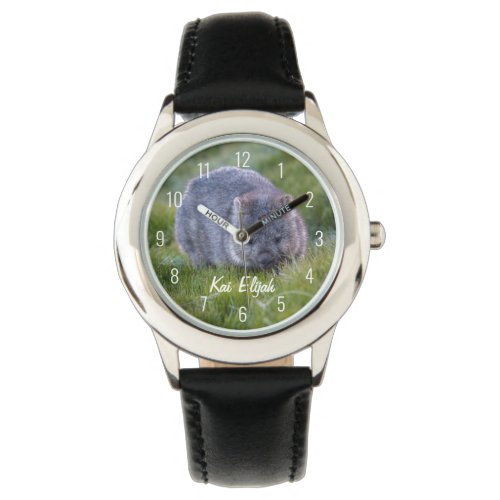Cute Wombat Animal Australia Eating Grass Watch



It's always time for a cute wombat! This kids watch features a close up photo of this adorable animal eating some grass in summer! Don't forget to personalize it with your own name (or delete the text if you just want to enjoy the image). The wombat (Vombatus ursinus) is the largest burrowing mammal. Indeed, it is such an accomplished burrower that early settlers called it a 'badger'. However, its closest relative is in fact the koala. With its short tail and legs, characteristic waddle and 'cuddly' appearance the wombat is one of the most endearing of Australia's native animals. The common wombat was once found throughout southeastern Australia but now, partly as a result of European settlement, is restricted further to the south. It occupies Tasmania, eastern New South Wales and eastern Victoria with scattered populations in southeastern South Australia and southwestern Victoria. There are three subspecies of common wombat - Vombatus ursinus hirsutus which is found on the mainland, Vombatus ursinus tasmaniensis which is found in Tasmania and Vombatus ursinus ursinus which was once found throughout the Bass Strait islands but is now restricted to Flinders Island. It is a fairly large, solidly built animal with a squat, round, bearlike body, small ears and eyes, and a large nose. Its thick, coarse fur varies in color from sandy brown to gray and black, and is sometimes flecked with fawn. Often their true color is obscured by the color of the dirt or clay in which they have been digging. On the mainland they average 1 m in length and 27 kg in weight yet can reach up to 1.2 m in length and weights of up to 35 kg. The Tasmanian Wombat is not as large or bulky, averaging 85 cm in length and 20 kg in weight, while the Flinders Island wombat is smaller still at only 75 cm in length. They have short legs, large paws and long, strong claws which are used in the excavation of burrows. The forepaws are used for digging and after pushing the dirt to one side the wombat will back out, moving the loose dirt with both the front and back paws. It differs from all other marsupials by having a single pair of upper and lower incisors (front teeth). These teeth are never ground away as they are both rootless and never stop growing; which is just as well as the wombat often uses them for cutting through obstructions, much like a beaver! Being marsupials, female wombats have a pouch that in their case opens backward to prevent dirt and debris entering while burrowing.


